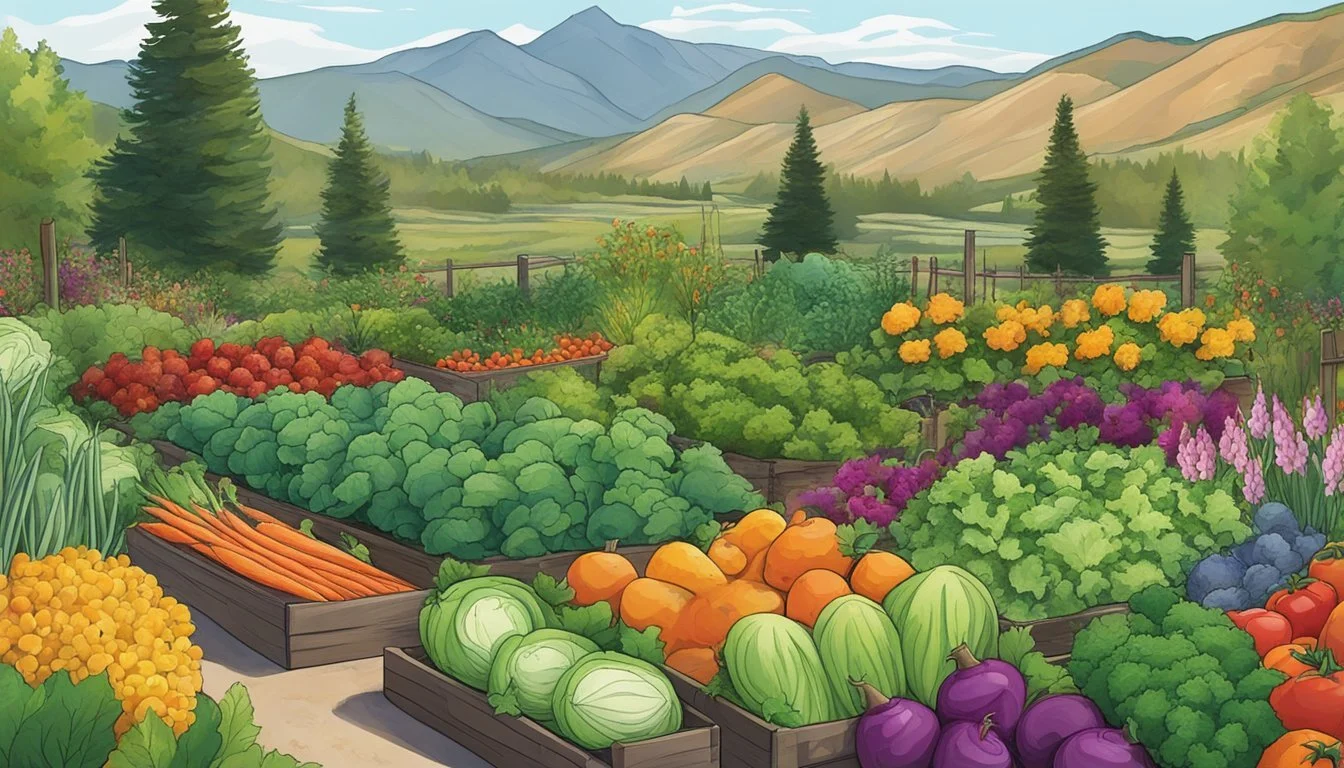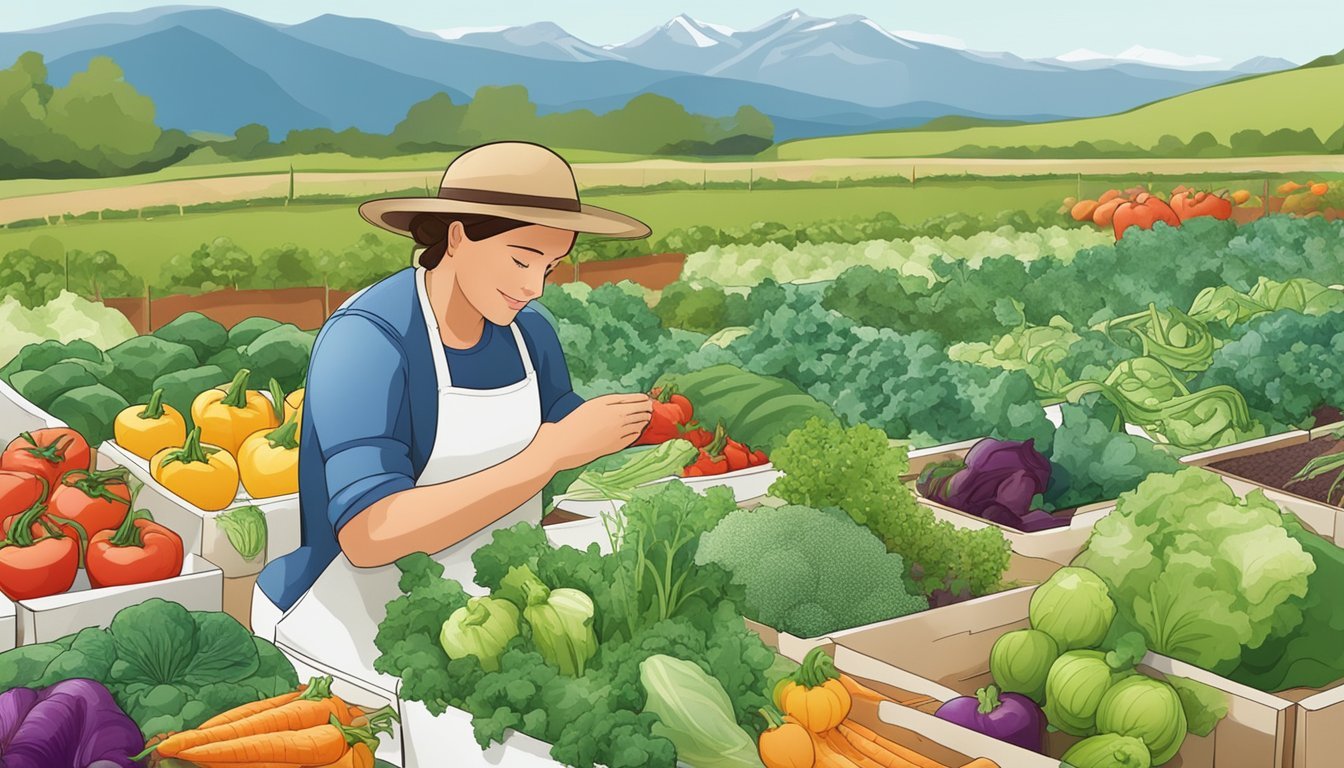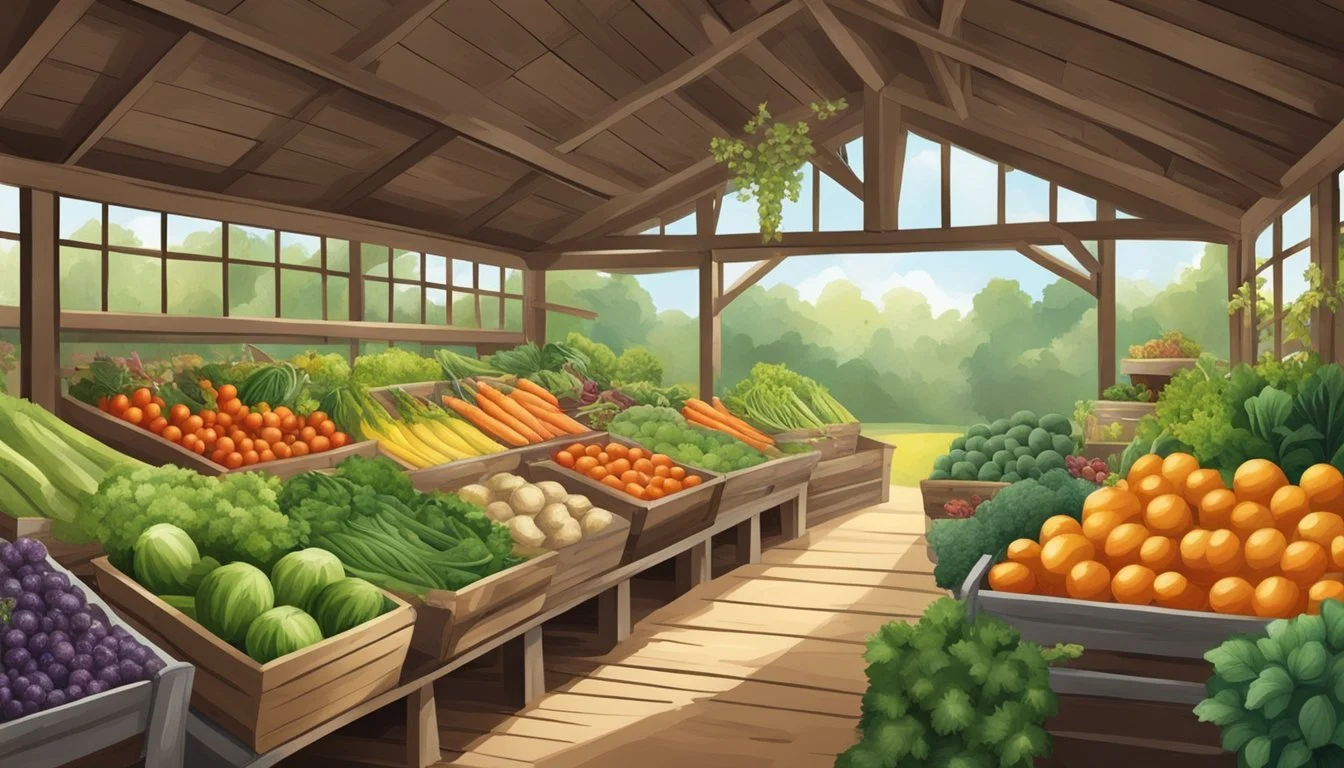Vegetable Gardening in Idaho
Maximizing Yield in the Gem State's Climate
This Article is Part of Our Guide on Vegetable Gardening by State
Idaho's diverse climate presents a unique environment for vegetable gardening, making it both a challenging and rewarding endeavor. The state spans several USDA hardiness zones, offering a range of conditions suitable for a variety of vegetables. Enthusiasts find that growing their own produce in Idaho not only yields delicious fruits of labor but also provides a fulfilling experience in tune with the region's natural cycle.
Vegetable gardening in Idaho takes advantage of the state's distinct seasons. Cool-weather crops like lettuce, kale, and peas flourish in the spring and fall when temperatures are mild. On the other hand, warm-weather plants such as tomatoes, squash, beans, and peppers thrive during Idaho's sunny, summer months. Gardeners in Idaho can maximize their yield by understanding the unique timing and care required for each plant variety in their specific location within the state.
By employing proper planting schedules and understanding the local climate patterns, Idaho gardeners can ensure a successful harvest. Whether one is situated in the cooler northern regions or the warmer southern areas of the state, the key to a fruitful garden lies in selecting the right plants and adjusting to the seasonal conditions. This approach allows gardeners to enjoy a bounty of vegetables, contributing to a sustainable and self-sufficient lifestyle.
Understanding Idaho's Climate
Idaho's diverse climate presents a variety of growing conditions for gardeners. Understanding the state's climate zones, weather patterns, and frost dates is critical for successful gardening.
Climate Zones and Hardiness
Idaho spans several USDA plant hardiness zones, ranging from zone 3 to zone 7. Northern Idaho typically falls within zones 3 to 5, while southern Idaho may range from zones 5 to 7. These zones are essential to consider when selecting plants, as they indicate the average minimum temperature ranges of the region.
Zone 3: -40 to -30°F
Zone 4: -30 to -20°F
Zone 5: -20 to -10°F
Zone 6: -10 to 0°F
Zone 7: 0 to 10°F
Weather Patterns and Gardening Implications
The weather in Idaho can fluctuate considerably between the northern and southern parts of the state. Northern Idaho experiences cooler and wetter conditions, making it ideal for cold-hardy plants. Southern Idaho, with its warmer and drier climate, can support a different variety of crops fit for those conditions. Gardeners must adapt their planting strategies to align with local weather patterns, ensuring plant varieties can thrive in either cooler or warmer temperatures as applicable.
Frost Dates and Seasonal Planning
Frost dates are pivotal for Idaho gardeners when planning the growing seasons. The frost-free period in Idaho can be as short as fewer than 110 days in some high-altitude areas. Spring planting should occur after the last expected frost date, while fall crops need to be harvested before the first fall frost.
Northern Idaho:
Last Frost: Late May to mid-June
First Frost: Early September
Southern Idaho:
Last Frost: Mid to late April
First Frost: Mid-October
Successfully managing the challenges presented by Idaho's climate can lead to a rewarding gardening experience. It requires careful attention to local climate zones, seasonal weather patterns, and critical frost dates for both planting and harvesting times.
Preparing Your Garden
When starting a vegetable garden in Idaho, a gardener's success hinges on selecting the ideal location, preparing the soil meticulously, and considering the benefits of raised garden beds.
Selecting the Right Location
A vegetable garden requires a location that receives full sun—at least six hours of direct sunlight per day. The orientation of the garden is crucial, with the north end having taller crops like corn to avoid shading shorter plants. Ideal locations will also be protected from strong winds and close to a water source for easier irrigation.
Soil Preparation and Amendments
The foundation of a successful garden is its soil. In Idaho, the soil often contains a high percentage of clay, which can be heavy and impede drainage. To improve soil structure and fertility:
Add organic material like compost to enrich the soil, which can help with nutrient content and soil texture.
Test the soil pH and nutrient levels to determine if specific amendments are needed.
Table of Amendments for Idaho Soils:
Amendment Purpose Application Rate Compost Adds organic matter, improves texture 2-3 inches annually Sand Improves drainage in clay soil 3-4 inches for start Lime Raises pH of acidic soils Follow soil test recommendation
Raised Garden Beds and Their Advantages
Raised garden beds bring several advantages to the Idaho gardener:
They offer excellent drainage, a key for areas with heavy clay soils.
The soil warms up faster, extending the growing season.
They can be filled with a custom soil mix, providing perfect growing conditions for a variety of vegetables.
Raised beds should be located in an area that receives adequate sunlight and has access to water. Utilizing quality materials for the construction of raised beds, such as untreated cedar or stone, can ensure longevity and reduce the risk of contaminating the soil with preservatives.
Choosing Vegetables to Plant
In the varied climate of Idaho, gardeners can achieve a bountiful harvest by carefully selecting appropriate vegetable varieties and adhering to recommended planting schedules.
Best Vegetables to Grow in Idaho
Idaho's climate is favorable for a range of vegetables. For cool weather, gardeners can opt for lettuce, kale, peas, and radishes. These thrive in the spring and fall. In contrast, tomatoes, squash, beans, and peppers perform best in Idaho's warmer summer conditions.
Root vegetables: Carrots and onions do well in Idaho's soil, along with other tubers.
Leafy greens: Besides lettuce and kale, collard greens (how long do collard greens last?) are a satisfying choice.
Fruiting vegetables: Tomatoes, cucumbers, and zucchini need more heat, hence summer planting is ideal.
Varieties and Transplants
When planting in Idaho, selecting the right varieties is crucial to success. For instance, short-season variants of tomatoes or squash are more likely to reach maturity before the first frost. Similarly, cold-hardy varieties of lettuce or kale can withstand cooler temperatures.
Direct sow vs. transplants: Root vegetables like carrots and radishes should be direct-sown, while tomatoes and peppers often benefit from starting as transplants indoors to extend their growing season.
Seasonal Planting Schedules
Adhering to a planting schedule is vital. Cool-season vegetables should be planted after the last spring frost date. They can often be replanted for a fall harvest. Warm-season vegetables, however, need to be planted after the soil has warmed sufficiently in late spring or early summer.
Spring: Peas, lettuce, and other leafy greens can be sown as early as the soil can be worked.
Summer: Seedlings of tomatoes, peppers, and beans should be planted once the danger of frost has passed.
Fall: Fast-growing cool-season crops like radishes can be planted in late summer for a fall harvest.
Gardening Techniques
Effective gardening techniques are essential for a thriving vegetable garden in Idaho. Gardeners should focus on specific watering and irrigation practices, apply calculated fertilization strategies, and implement careful pest management for optimal plant health and productivity.
Watering and Irrigation
In Idaho, where water conservation is key, gardeners should employ drip irrigation or soaker hoses to deliver water directly to plant roots, minimizing evaporation and waste. Watering should occur early in the morning to reduce fungal diseases and allow plants to dry before nightfall. It's crucial to provide plants with 1 to 2 inches of water per week, considering both rainfall and manual watering.
Fertilization Strategies
Balanced fertilization is essential for plant vigor. Gardeners are recommended to use a mix of fertilizer and organic material, such as compost or manure. Start with a soil test to determine nutrient needs. Then, apply fertilizers in accordance with plant requirements—usually at planting and throughout the growing season. Organic options like fish emulsion or blood meal can provide nutrients while building soil health.
Pest Management and Protection
To protect plants from pests, Idaho gardeners should adopt integrated pest management techniques. Regularly inspect plants for signs of damage and identify pests early. Use physical barriers, such as row covers, to protect crops from insects. Introduce beneficial insects like ladybugs that will eat aphids and other harmful pests. If necessary, apply organic or chemical pesticides judiciously, strictly following label instructions to prevent overuse and harm to beneficial organisms.
Harvesting and Storage
In Idaho, vegetable gardeners must carefully time their harvests and employ proper storage methods to ensure the longevity and freshness of their produce.
Timing and Methods
Carrots and radishes should be harvested when their roots reach a usable size, typically when their diameter is about half an inch. Lettuce and peas are best harvested in the cool of the morning for optimal crispness. Beans, peppers, and tomatoes should be harvested as they mature, bearing in mind that regular harvesting encourages further production.
Carrots/Radishes: Harvest when diameter reaches ~0.5 inch.
Lettuce/Peas: Harvest in the morning for peak freshness.
Beans/Peppers/Tomatoes: Harvest at maturity; increases yield.
Storing Vegetables for Longevity
To maintain freshness, vegetables require proper storage conditions. Carrots and radishes can last for several months when stored at near-freezing temperatures with high humidity. Lettuce is best kept in the refrigerator in a perforated bag. Meanwhile, peas should be shelled, blanched, and frozen to preserve their quality. Tomatoes ripe for eating can be stored at room temperature, whereas underripe tomatoes should be kept at a cooler, but not cold, temperature to finish ripening. Beans have a short shelf-life and are best consumed within a week or preserved through canning or freezing for longer storage.
Carrots/Radishes: Store in near-freezing temperatures, high humidity.
Lettuce: Refrigerate in a perforated bag.
Peas: Shell, blanch, freeze.
Tomatoes: Store ripe ones at room temperature; underripe in cool area.
Beans: Consume within a week or preserve for later use.
Idaho Gardening Resources
Those interested in vegetable gardening in Idaho have access to an abundance of resources ranging from local community support to specialized garden stores and nurseries. These resources provide Idaho gardeners with the necessary tools, advice, and inspiration to succeed in various climates and spaces.
Local Community and Support
Boise and surrounding areas, such as Meridian, Nampa, and Caldwell, are home to active gardening communities that offer a wealth of knowledge and support. Several community gardens allow individuals to learn and grow together, sharing experiences and successes. The University of Idaho Extension also offers classes and workshops for both novice and experienced gardeners looking to enhance their skills.
Twin Falls and Post Falls host horticultural classes and educational programs through community centers and extension services.
In Lewiston, gardeners can find community support through local gardening clubs and online forums dedicated to Idahoan horticulture.
Garden Stores and Nurseries
Garden stores and nurseries across Idaho cater to the specific needs of the region's gardeners. They offer an array of plants suitable for Idaho's three distinct growing regions, including high-quality vegetable seeds and starts that are cold hardy and drought-resistant.
Nurseries in Boise:
Boise Garden Center - Specializes in organic seeds and plants for small spaces.
Eden Nursery - Offers extensive options for vegetable and herb gardening.
Garden Stores in Meridian & Nampa:
Green Thumb Emporium - Provides sustainable gardening supplies and expert advice.
Nampa Garden Market - Focuses on locally-sourced plants and offers garden design services.
These establishments frequently hold workshops and provide personalized guidance for selecting the best plants and garden supplies to thrive in Idaho's unique conditions.
Getting Started in Idaho Gardening
Venturing into the realm of gardening in Idaho presents a rewarding opportunity for green thumbs looking to grow a variety of vegetables, fruits, and herbs. With distinct climate conditions, it's crucial for new gardeners to equip themselves with region-specific advice for a flourishing garden.
Basic Tips for Beginners
When starting a garden in Idaho, understanding the local climate is paramount. Idaho falls within USDA plant hardiness zones 3-7, which dictates the growing conditions for plants. Frost dates are particularly important for timing the planting of seeds and transplanting seedlings to ensure they thrive. Beginners should consider starting with cold-hardy vegetables such as lettuce, which can endure frost and even light snow.
Soil health is the foundation of a robust garden. Gardeners should test their soil to identify its type and nutrient composition, amending it with organic matter to improve fertility and drainage.
It's also beneficial to start small to manage the new experience without feeling overwhelmed. Begin with a manageable-sized plot or even container gardening to grow a selection of healthy plants. Starting small allows gardeners to focus on learning about each plant's needs and adjusting care techniques as necessary. Here’s a consistent approach for first-time gardeners:
Select the right location: Look for a spot with at least six hours of sunlight.
Choose suitable plants: Cold-tolerant crops like lettuce, kale, and spinach are ideal.
Prepare the soil: Enrich with compost and ensure proper drainage.
Plan for watering: Consistent moisture is key, but avoid overwatering.
Protect from frost: Use straw or garden blankets if an unexpected frost is forecasted.
Expanding Your Gardening Skills
As gardeners gain experience, they can start expanding their skill set by incorporating a wider variety of plants and adopting more advanced gardening practices. Crop rotation is one technique that prevents soil depletion and reduces the risk of pests and diseases. This involves planning the garden so that the same crop isn't planted in the same location each year.
For those who wish to enhance the beauty and productivity of their garden space, understanding the companionship of plants is another valuable skill. Certain plants, when grown together, can offer mutual benefits such as pest deterrence and improved pollination.
Experienced gardeners may also delve into growing a diverse range of vegetables, fruits, and herbs, which can provide fresh produce for eating and contribute to the aesthetic appeal of the garden. Personal experience and ongoing learning are key in developing a garden that becomes more bountiful and enjoyable with each season.
In summary, successful Idaho gardening starts with basic knowledge suited to the local environment and progressively expands into more complex gardening practices. It's a journey of learning, experience, and enjoyment in the process of growing and ultimately eating the beauty one cultivates.
Advanced Gardening Topics
For the experienced gardener in Idaho seeking to optimize growth and extend their harvest, mastering year-round gardening techniques and employing structures like greenhouses and row covers are crucial. They protect plants from harsh conditions and capitalize on Idaho's unique climate.
Year-Round Gardening Approaches
In Idaho, year-round gardening implies the strategic use of plant varieties and timing. Gardeners should focus on cool-weather crops such as lettuce and kale for the spring and fall, while warm-weather plants like tomatoes should be reserved for summer. Raised beds enhance soil drainage and warmth, allowing for an earlier start in spring. Dividing plants periodically can ensure healthy, prolific growth. By doing so, gardeners can keep their garden productive through multiple seasons.
Spring: Plant cool-weather crops as soon as the soil can be worked.
Summer: Transition to warm-weather vegetables once the last frost has passed.
Fall: Sow fast-growing cool season crops for a late harvest.
Winter: Use protective structures or plant cold-hardy varieties that can survive snow and frost.
Utilizing Greenhouses and Row Covers
Greenhouses offer an environment where temperature and humidity can be controlled, thus extending the growing season for a variety of plants.
Greenhouses:
Benefits: Allows for a controlled microclimate that can support plant growth year-round.
Usage: Start seedlings early, grow heat-loving plants through the cooler months, or overwinter sensitive perennials.
Row Covers:
Lightweight: Protects from frost, still allows light and rain to reach the plants.
Heavyweight: Offers insulation against extreme cold, suitable for winter protection.
These advanced techniques require investment and expertise but reward gardeners with increased productivity and the enjoyment of gardening throughout the year.
Inspirational Ideas for Your Garden
Creating an inspirational garden in Idaho hinges on thoughtful design and the intermingling of various plants, ranging from robust vegetables to delicate herbs and fruits. This section explores how to elevate the aesthetic of your garden while making the most of Idaho's diverse climate.
Garden Design and Aesthetics
When considering garden design, Idahoans have the potential to craft spaces that are both functional and beautiful. One might balance the robust lines of broccoli with the feathery textures of grasses or flowers to achieve visual harmony. The vibrant red of jalapenos can punctuate a green canvas. Using raised beds or containers is an effective method to maximize yields, especially in small spaces.
Color Coordination: Plant beets near green leafy vegetables to introduce a splash of purple.
Textures: Introduce a variety of leaf types to add depth; for example, the contrast between the ruffled leaves of Brussels sprouts and the smoother leaves of herbs.
Leverage vertical gardening solutions to optimize space and add visual interest:
Trellises for climbing plants like green peas
Vertical planters to integrate into patio areas or balconies
Incorporating Fruits and Herbs
In addition to vegetables, incorporating fruits and herbs can enhance the garden's aesthetics and functionality. Herbs such as basil or mint not only offer culinary benefits but also provide sensory pleasure with their aromatic leaves.
June is an ideal time to introduce warm-season fruits like strawberries, which can serve as a ground cover while yielding sweet rewards. For coherence in design, consider symmetrical planting or the creation of focal points with fruit-bearing shrubs.
A well-planned herb and fruit integration strategy includes:
Herb Borders: Line walkways or garden perimeters with herbs to add fragrance and easy access for cooking.
Companion Planting: Plant herbs like dill and parsley alongside vegetables to promote pollination and pest control.
By integrating the practical with the beautiful, gardeners can achieve an inspired space that thrives throughout the seasons in Idaho.







